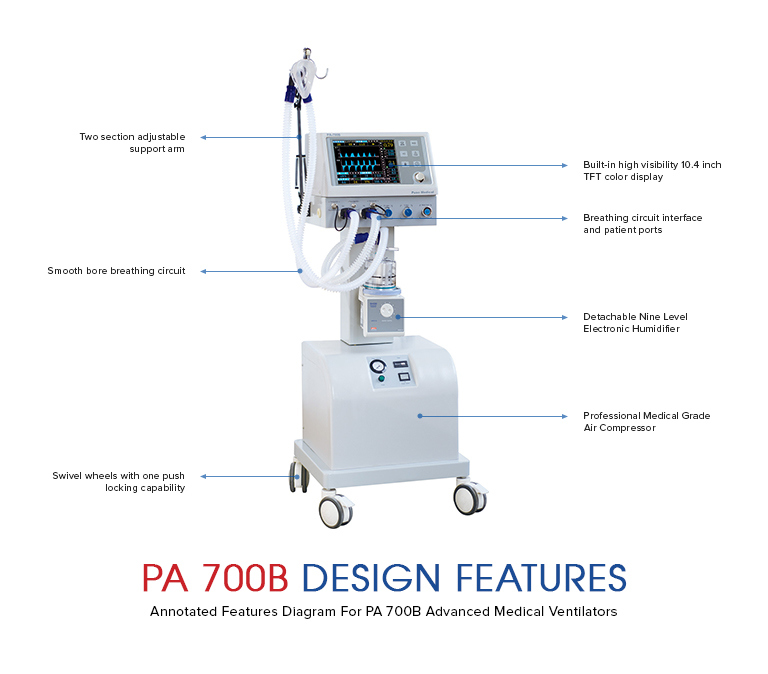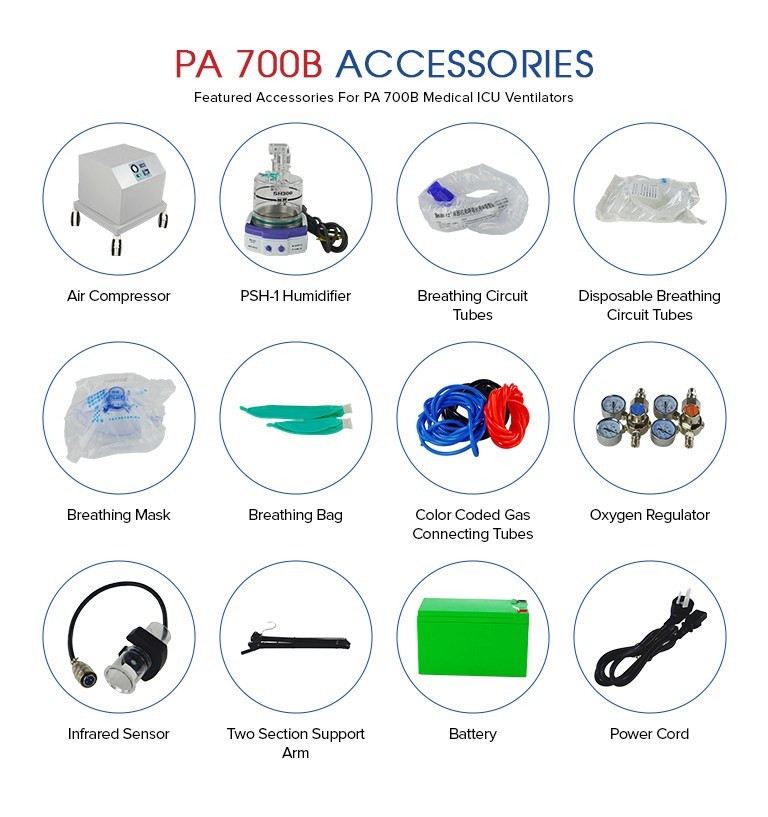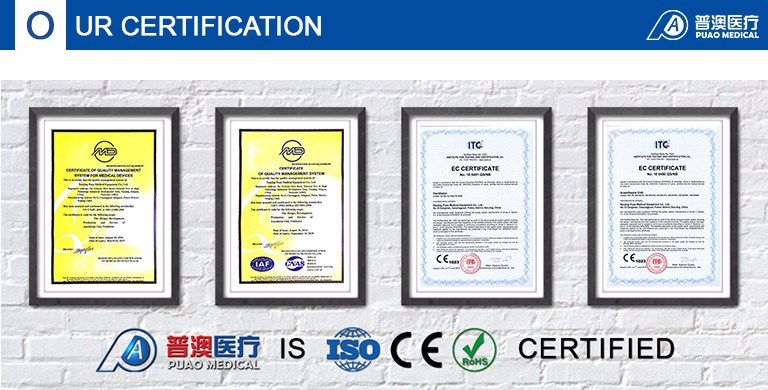

Common Features
Operating Modes: Pneumatically driven & electronically controlled, closed, semi-closed and semi-open
Pneumatically driven electrically controlled ventilator, can be used for emergency clinical resuscitation and respiratory therapy
Nonhazardous environmentally friendly frame, precise construction, elegant design, equipped with automated self-checking function during startup and an automatic self-calibrating sensor
Display: Built-in 10.4 inch high visibility color TFT display, able-simultaneously display Pressure-Time and Frequency-Time waveforms in real timeÂ
Sigh: Ability to insert 1-8 sigh breaths in every 100 breaths, ventilation should be no less than 1.5 the tidal volume
Equipped with infrared turbine flow sensor; precisely measures gas flows, stable and reliable
Power Failure Support Functions: Automatically converts-standby mode during AC power outages
9 Level adjustable humidifierÂ
Monitor Parameters: tidal volume, respiration rate, airway pressure, I:E ratio, inspiratory & expiratory status, inspiratory trigger and others
Alarms: Audible and/or visual alarms for ventilation volume, tidal volume, oxygen concentration, asphyxia, airway pressure, intubation disconnection, low oxygen, power failure and other alarms, also features a alarm history query function
Advanced Model Exclusive Features
Equipped with professional medical grade air compressor tailored for long clinical times and low noise requirements
Air Compressor
Air Compressor: 220V AC±10%, 50±1Hz, 700VA, also features good protective grounding against electrical activity
Output Gas Pressure: 0.4MPa±20%
Continuous output gas flow greater than or equal to 20L/min
Instantaneous output gas flow great than equal to 60L/min
Specifications
| Model | PA-700B (Advanced Model) |
| Display | 10.4 inch high visibility color TFT display |
| Ventilation Mode | A/C, IPPV, SIPPV, IMV, SIMV, Standby, SPONT MANUAL |
| Minute Volume | Greater than or equal to 18L |
| Back-up Power Supply | At least 4 hours |
| Tidal Volume | Adjustable range: 50-1500ml, Display range: 0-2000ml |
| Respiratory Rate | 1-99bpm |
| Inspiratory/expiratory (I:E) ratio | 4:1-1:4 |
| PEEP | 0-10cmH2OÂ |
| SIMV Rate | 1-20bpm |
| Inspiratory Pressure Trigger | -10-10cmH2OÂ |
| Trigger Sensitivity (flow) | 1-10L/m |
| Inspiratory Plateau | Adjustable from 0-50% of inspiratory time |
| Adjustable Oxygen Concentration | 21-100% |
| Gas Supply Requirement | 280~600 kPa medical grade oxygen and compressed air supply |
| Pressure Limit | 1.0kPa~6.0kPa |
| Maximum Safe Operating Pressure | ≤6.0kPa |
| Tidal Volume Alarm | Upper Limit: 10~2000ml, Lower Limit: 0~1800ml |
| Airway Pressure Alarm | Upper Limit: 0.1~6kPa, Lower Limit: 0~5kPa |
| Oxygen Concentration Alarm | Upper Limit: 22~100%, Lower Limit: 21~80% |




Â
Polysaccharides are polymeric carbohydrate molecules composed of long chains of monosaccharide units bound together by glycosidic linkages, and on hydrolysis give the constituent monosaccharides or oligosaccharides. They range in structure from linear to highly branched. Examples include storage polysaccharides such as starch and glycogen, and structural polysaccharides such as cellulose and chitin.
Polysaccharides are often quite heterogeneous, containing slight modifications of the repeating unit. Depending on the structure, these macromolecules can have distinct properties from their monosaccharide building blocks. They may be amorphous or even insoluble in water. When all the monosaccharides in a polysaccharide are the same type, the polysaccharide is called a homopolysaccharide or homoglycan, but when more than one type of monosaccharide is present they are called heteropolysaccharides or heteroglycans.
Natural saccharides are generally of simple carbohydrates called monosaccharides with general formula (CH2O)n where n is three or more. Examples of monosaccharides are glucose, fructose, and glyceraldehyde. Polysaccharides, meanwhile, have a general formula of Cx(H2O)y where x is usually a large number between 200 and 2500. When the repeating units in the polymer backbone are six-carbon monosaccharides, as is often the case, the general formula simplifies to (C6H10O5)n, where typically 40≤n≤3000.
As a rule of thumb, polysaccharides contain more than ten monosaccharide units, whereas oligosaccharides contain three to ten monosaccharide units; but the precise cutoff varies somewhat according to convention. Polysaccharides are an important class of biological polymers. Their function in living organisms is usually either structure- or storage-related. Starch (a polymer of glucose) is used as a storage polysaccharide in plants, being found in the form of both amylose and the branched amylopectin. In animals, the structurally similar glucose polymer is the more densely branched glycogen, sometimes called "animal starch". Glycogen's properties allow it to be metabolized more quickly, which suits the active lives of moving animals.
Cellulose and chitin are examples of structural polysaccharides. Cellulose is used in the cell walls of plants and other organisms, and is said to be the most abundant organic molecule on Earth.It has many uses such as a significant role in the paper and textile industries, and is used as a feedstock for the production of rayon (via the viscose process), cellulose acetate, celluloid, and nitrocellulose. Chitin has a similar structure, but has nitrogen-containing side branches, increasing its strength. It is found in arthropod exoskeletons and in the cell walls of some fungi. It also has multiple uses, including surgical threads. Polysaccharides also include callose or laminarin, chrysolaminarin, xylan, arabinoxylan, mannan, fucoidan and galactomannan.
Polysaccharide Series,Cordyceps Polysaccharide,Hericium Erinaceus Polysaccharide,Goji Polysaccharide
Excellent Health Products Co.,Ltd , http://www.sino-excellent.com